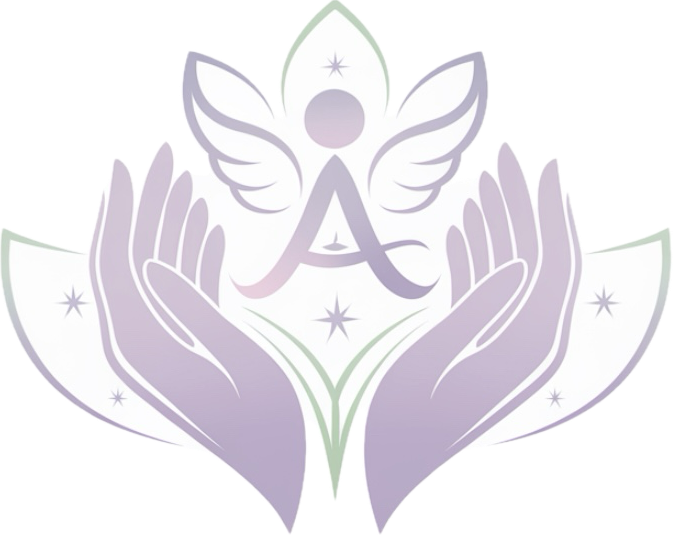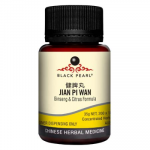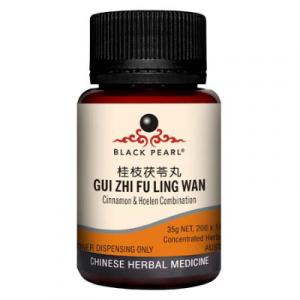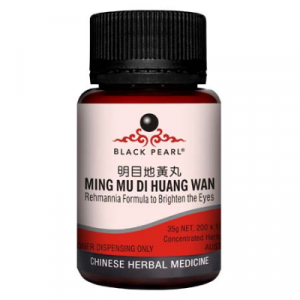Indication
There are several different formulas by the name of Jian Pi Wan (‘Strengthen the Spleen Pill’), all of which have the same clinical actions as described above. It was originally recorded in ‘Standards for Diagnosis and Treatment of Six Branches of Medicine’ (liu ke zheng zhi zhun sheng), by Wang Ken-tang (a.k.a. Wang Yu-tai or Wang Sun-an), 1602, which was the pre- eminent text on Chinese medicine in 17th century China.
Although the original formula contained thirteen ingredients, modern formulations typically contain only six. This is because the original included astringent herbs for the treatment of diarrhoea, along with extra Qi regulating herbs to treat abdominal bloating and/or focal distension. In addition there was a small amount of Coptis (huang lian) to clear Heat that develops due to stagnation. Thus, the scope of clinical applications for the larger formula was narrower than the smaller modern versions.
In addition, the use of astringent herbs in conditions with stagnation is generally not appropriate, as evidenced by their omission and the inclusion of immature citrus fruit (zhi shi) in most of the modern formulations. However, a better way to promote the astringing action of the Spleen Qi and to astringe the Intestines in cases with combined Spleen Qi deficiency and food stagnation (i.e. a mixed deficiency-excess syndrome of the middle Jiao) is by appropriate pre-preparation of the major ingredients, i.e. dry frying or roasting.
This variant does not include immature citrus fruit (zhi shi) because it is a strongly dispersing herb (i.e. it breaks up stagnant Qi and removes accumulation with a strongly downward- directing action) and is therefore poorly tolerated in patients with Qi deficiency of the middle Jiao. Thus, with six ingredients this formula is strongly focused on its specific treatment principles, allowing a broad range of clinical applications.
Furthermore, because of the economy of ingredients, it is compatible with a wide variety of other formulas in the treatment of patients with multiple TCM syndrome-patterns.
The synergistic actions of the herbs are as follows:
Codonopsis root (dang shen), Atractylodes rhizome (bai zhu), Poria cocos, (fu ling): tonify the Spleen Qi.
Codonopsis root (dang shen), Horderum sprout (mai ya), Atractylodes rhizome (bai zhu) – the first two dry-fried and the latter roasted: tonify the Spleen Qi and promote the containing action of the Qi.
Hordeum sprout (mai ya), Crataegus fruit (shan zha): reduce food stagnation and promote digestion.
Citrus peel (chen pi): regulates the Qi and harmonises the middle Jiao.
Indications:
Indigestion
Chronic gastritis
Duodentitis
Chronic enteritis
Peptic ulcer disease
Crohn’s disease
Inflammatory bowel disease
General debility due to chronic illness
Signs & Symptoms:
Poor appetite and digestion with: bloating after meals, belching, flatulence, acid reflux or nausea, loose stools
Distension and sense of fullness in the epigastrium or abdomen
Fatigue
Pain in the epigastrium or abdomen
Diarrhoea
Reluctance to speak
Pale tongue with a greasy white coat
Pulse is weak and also slippery or soft
Combinations –
Children with poor appetite:
SHEN LING BAI ZHU SAN
Food stagnation, severe:
BAO HE WAN
Malabsorption syndrome:
SHEN LING BAI ZHU SAN
HUO LUO XIAO LING DAN
HUO XIANG ZHENG QI WAN
TCM Syndromes: Food stagnation in the Stomach and Intestines, Spleen-Stomach Qi deficiency.
TCM Actions: Tonifies Stomach and Spleen, reduces food stagnation and promotes digestion, regulates the Qi and harmonises the middle Jiao.









Reviews
There are no reviews yet.